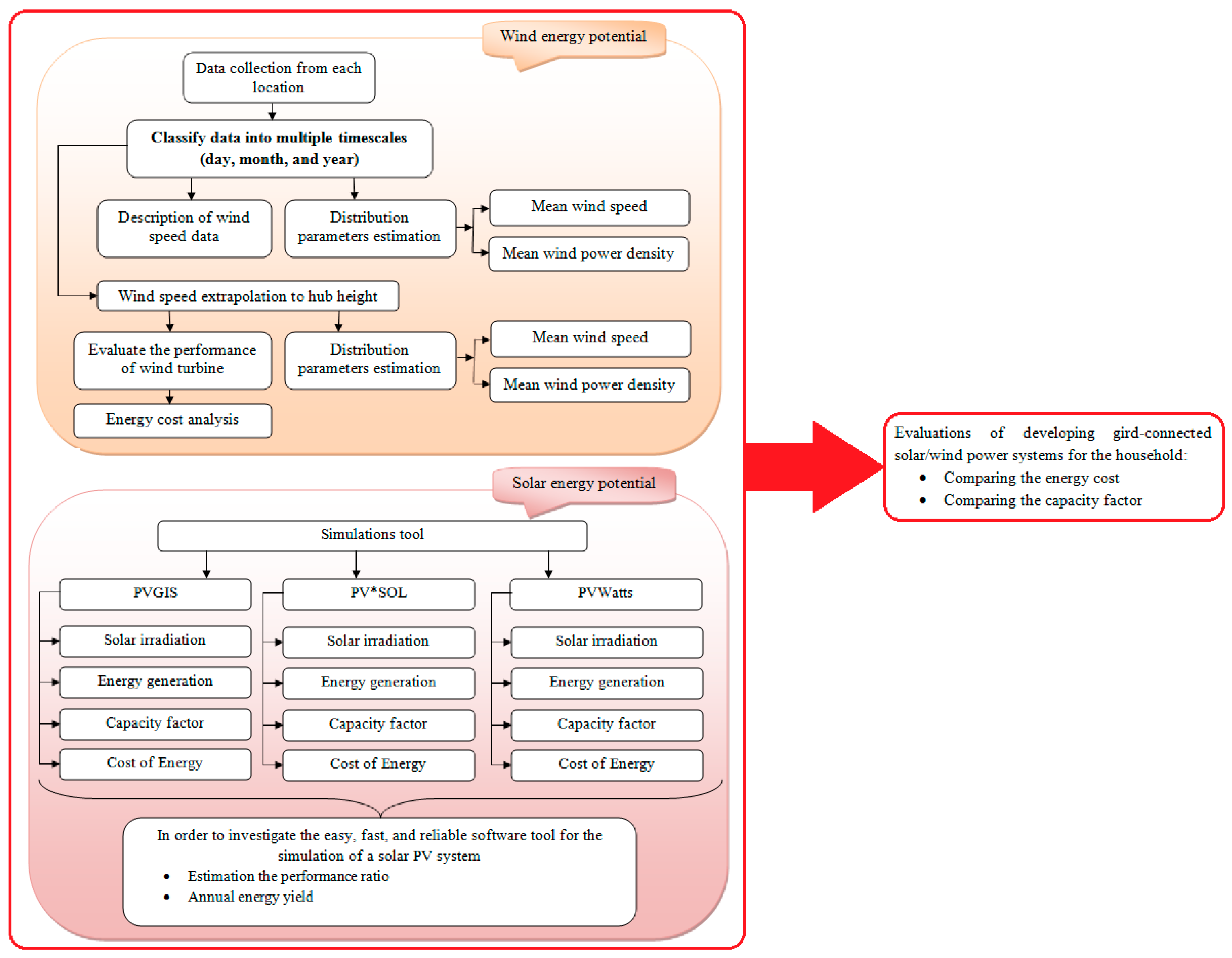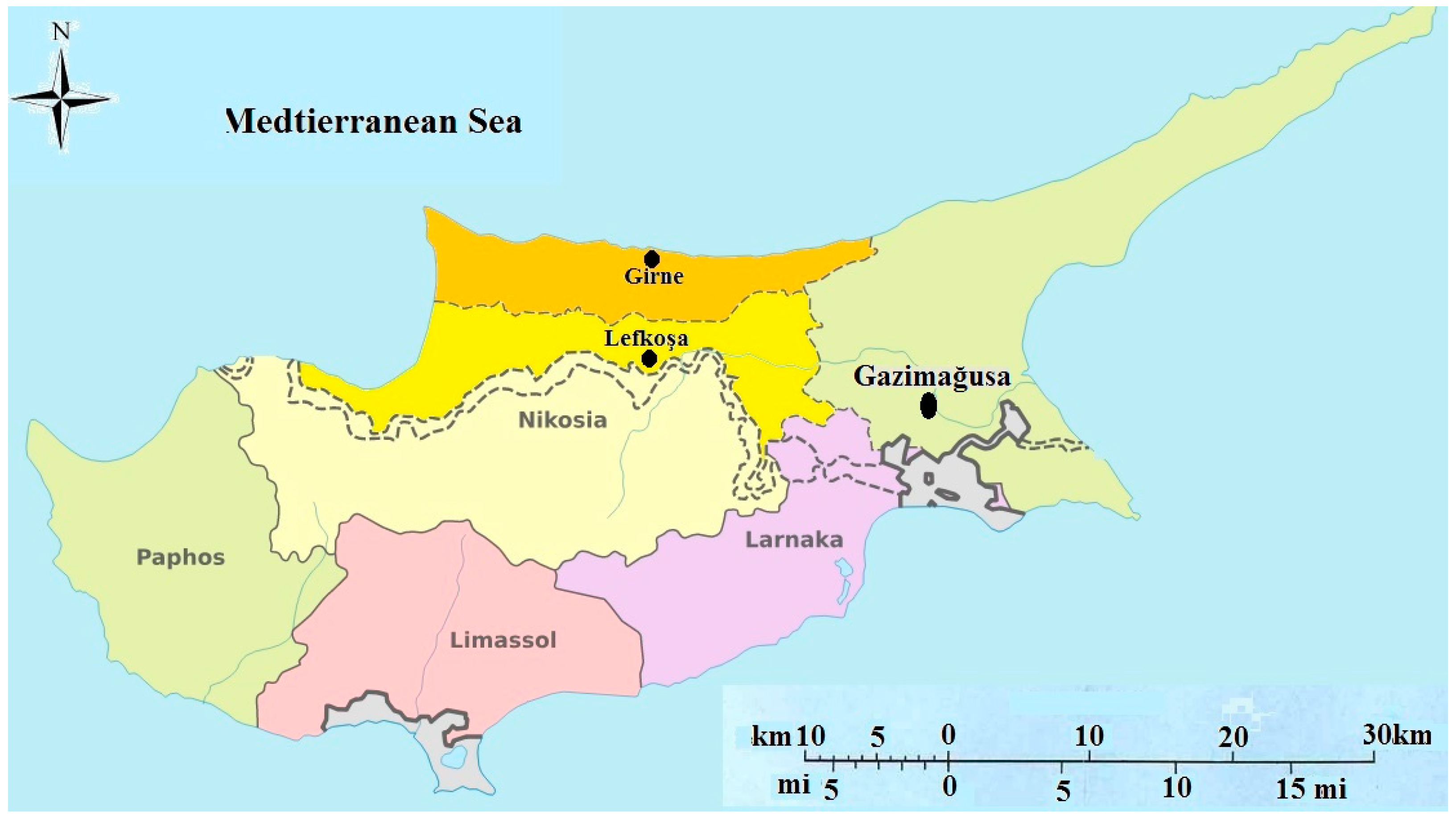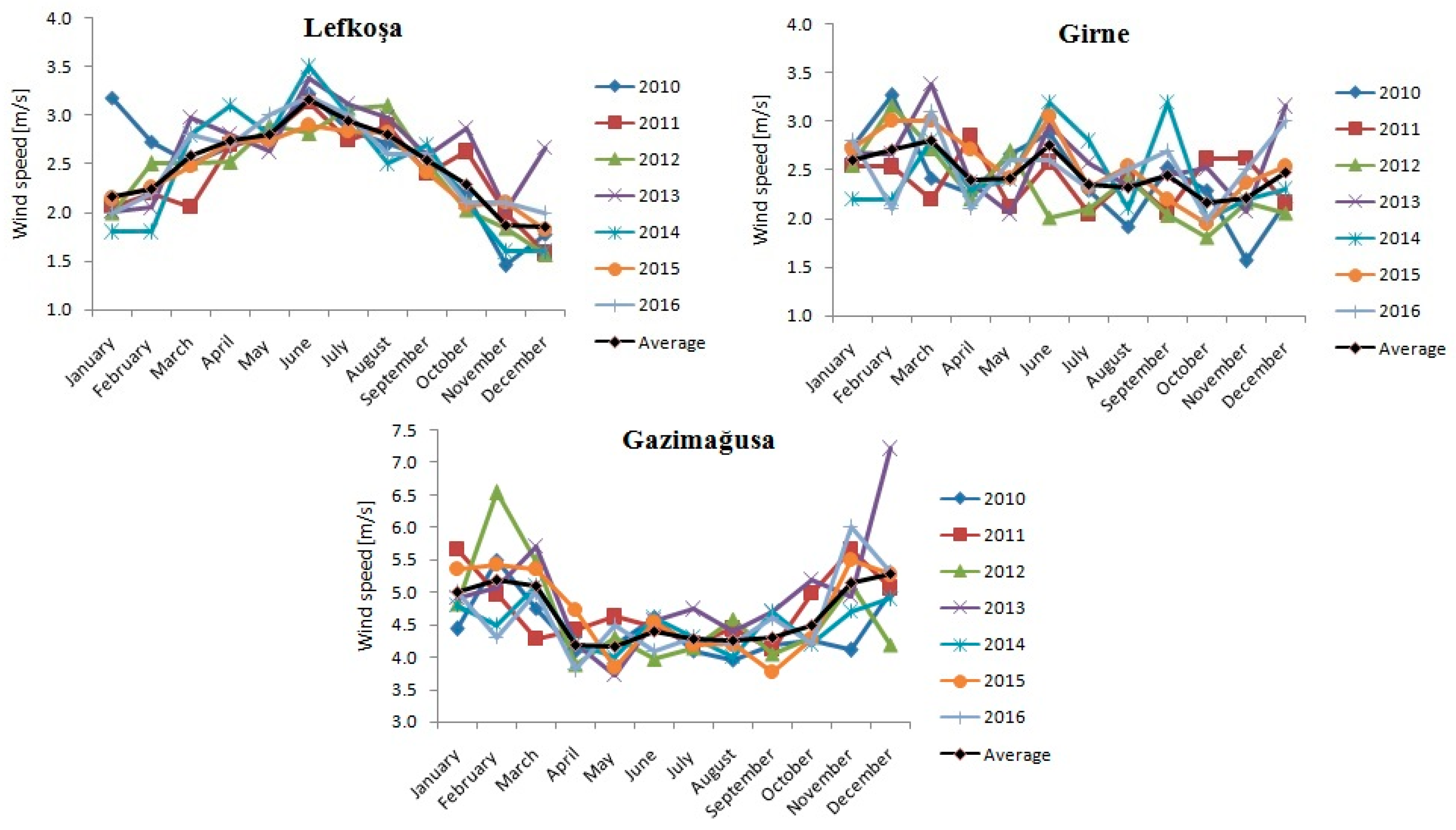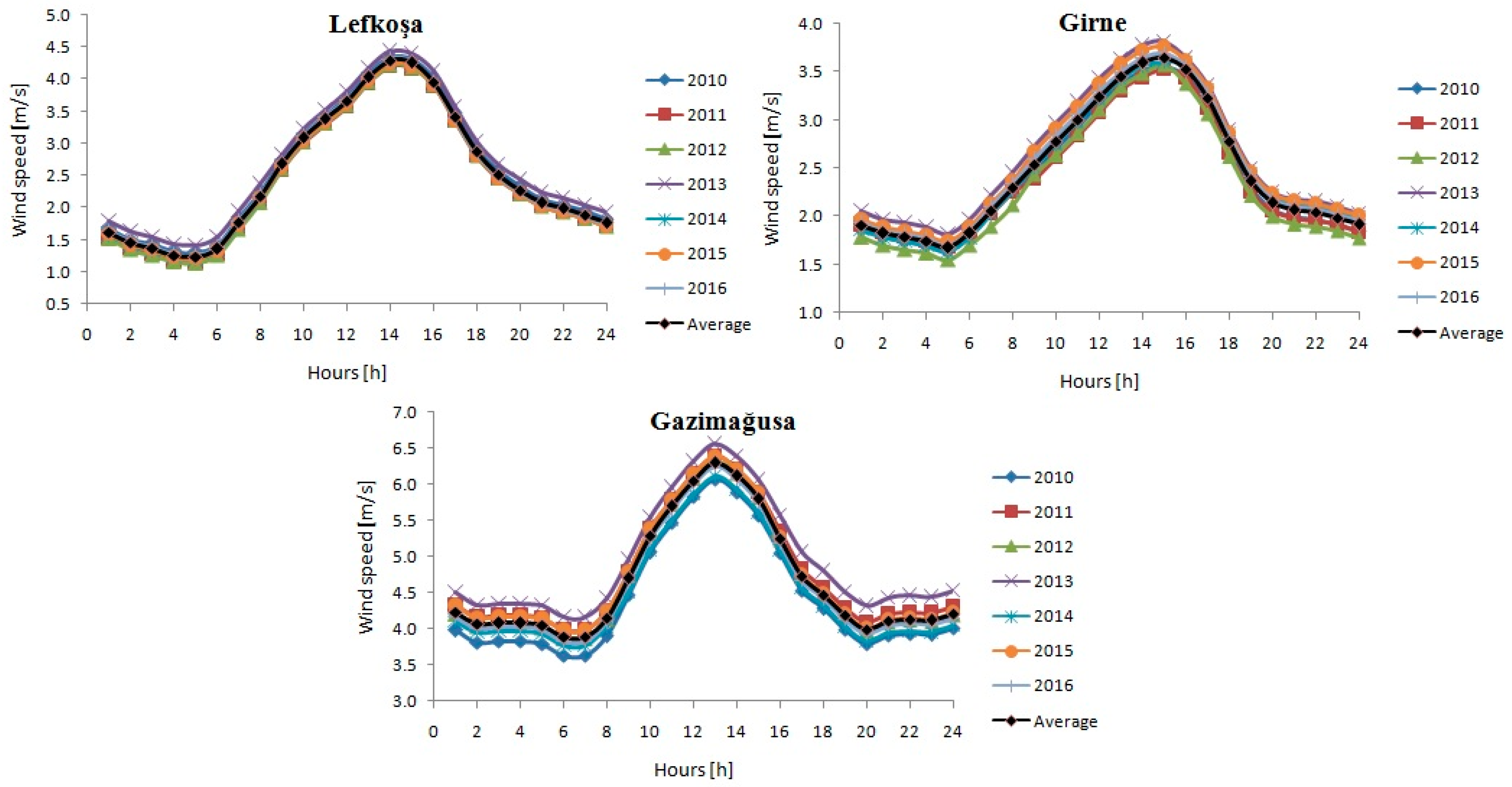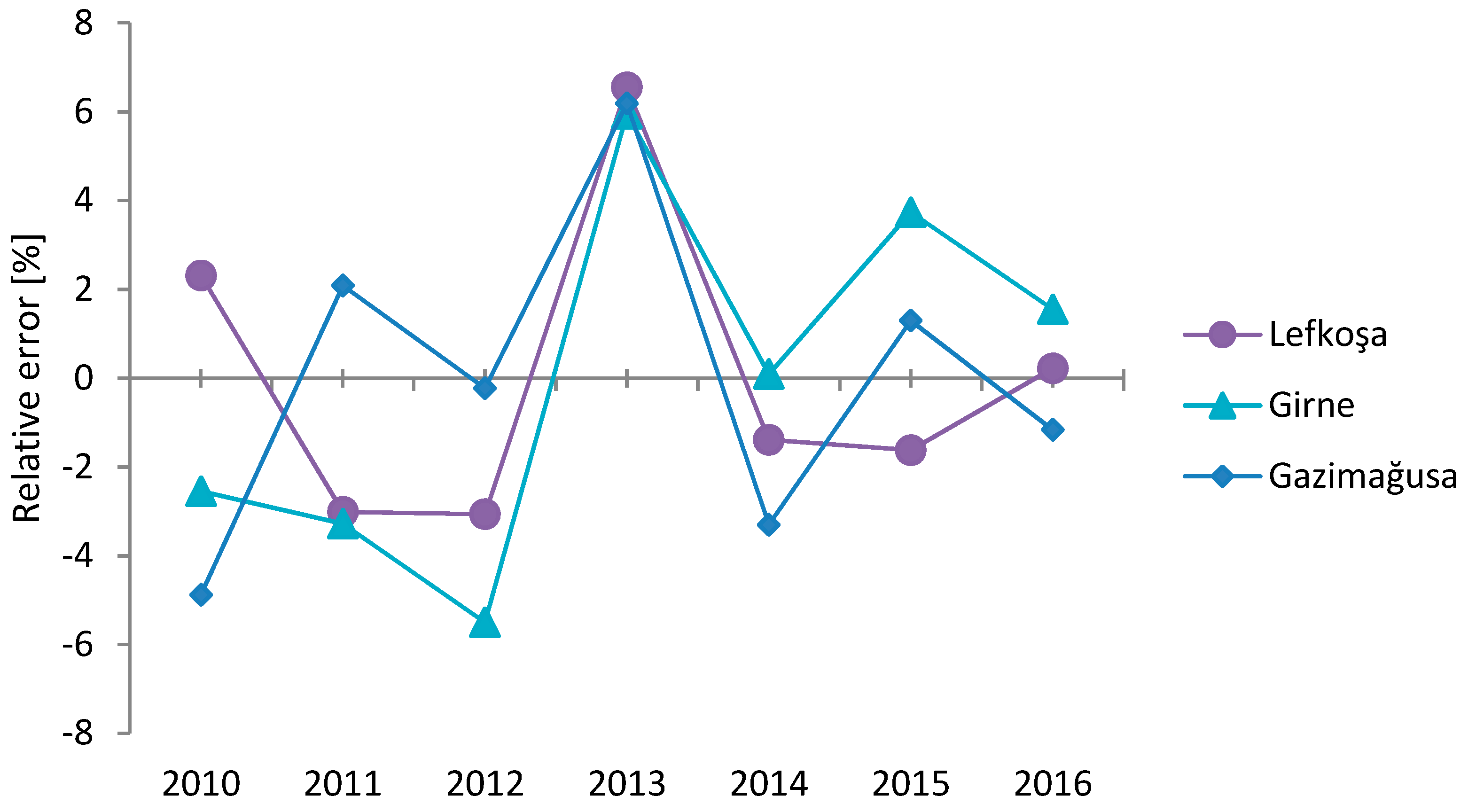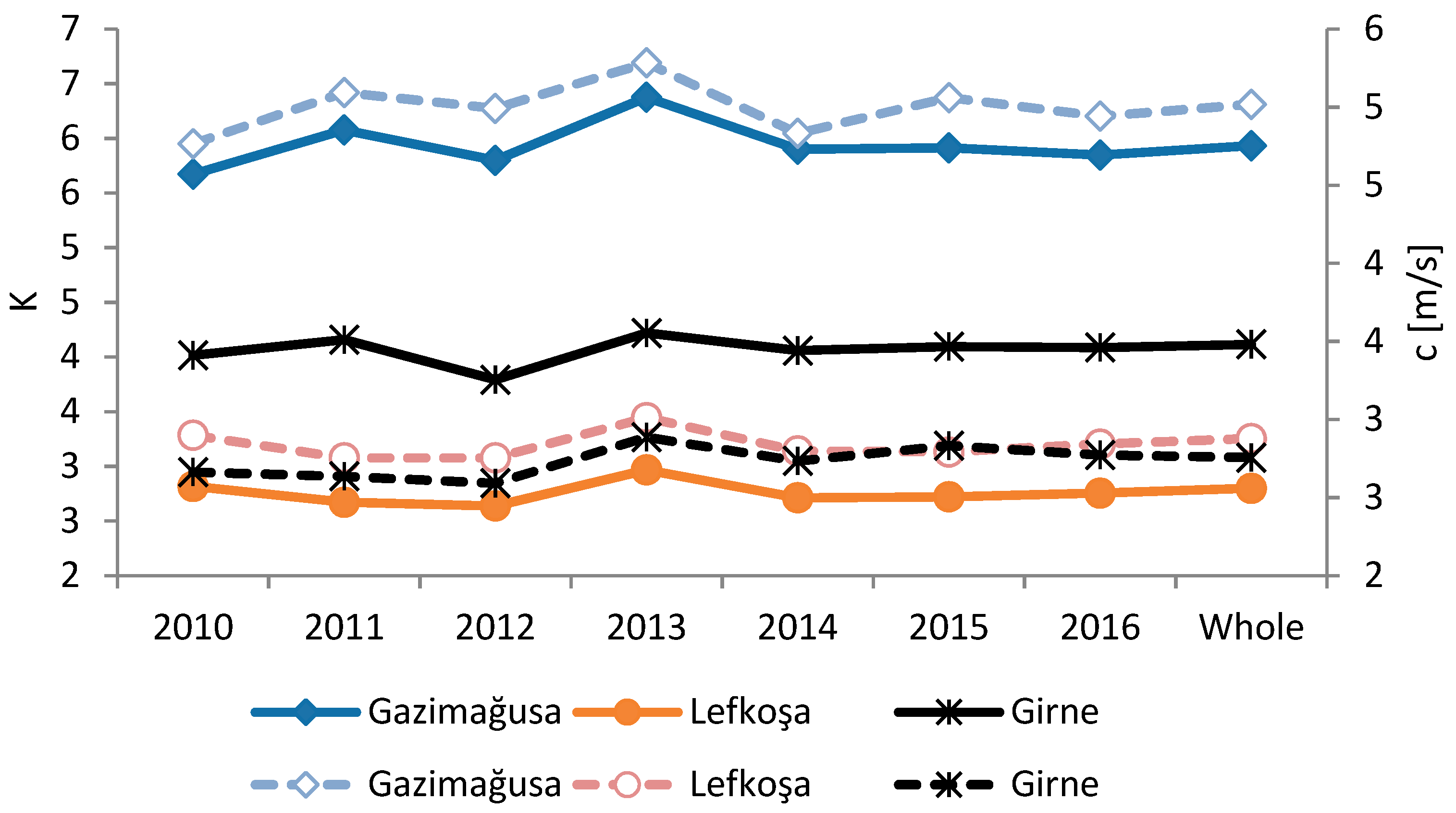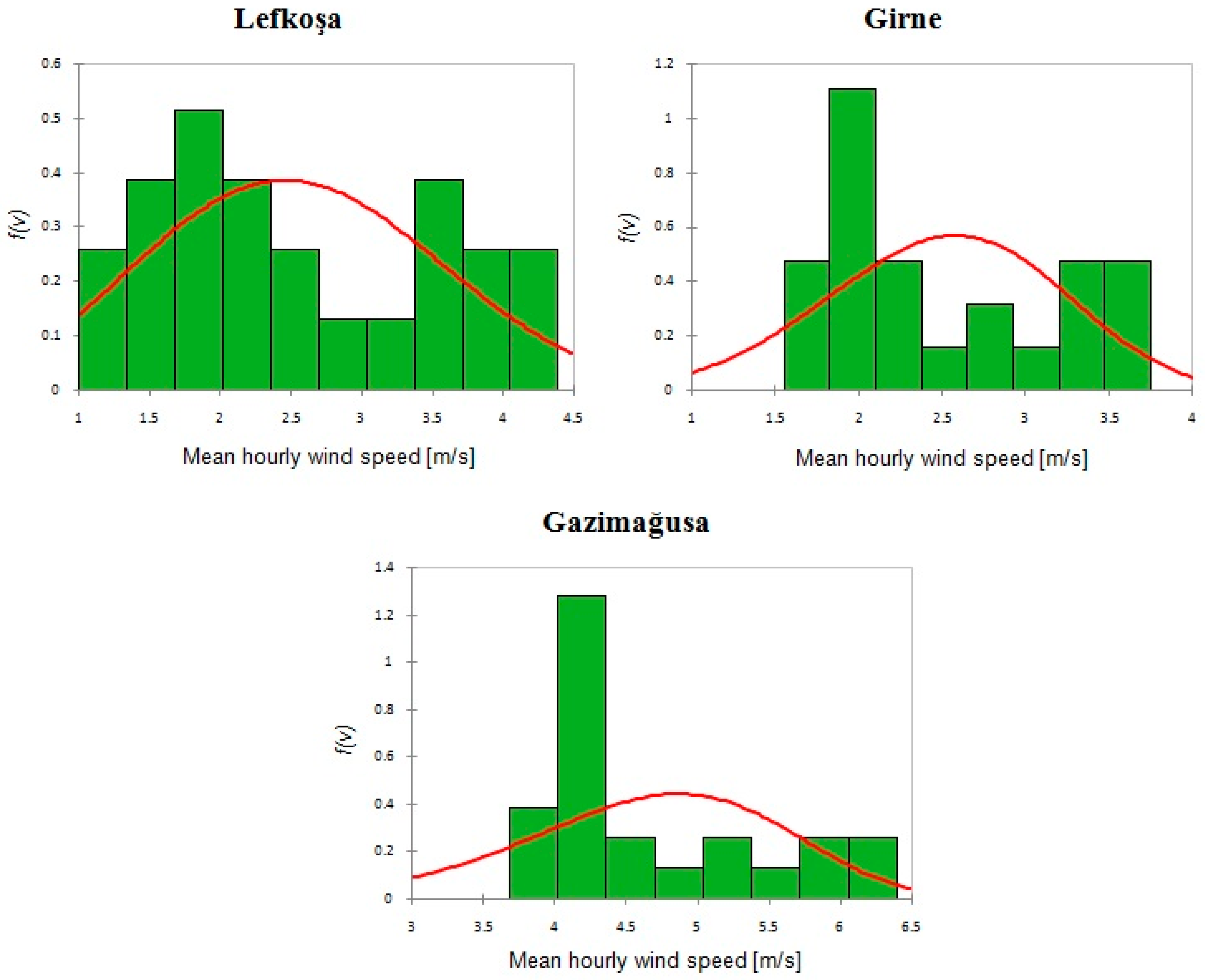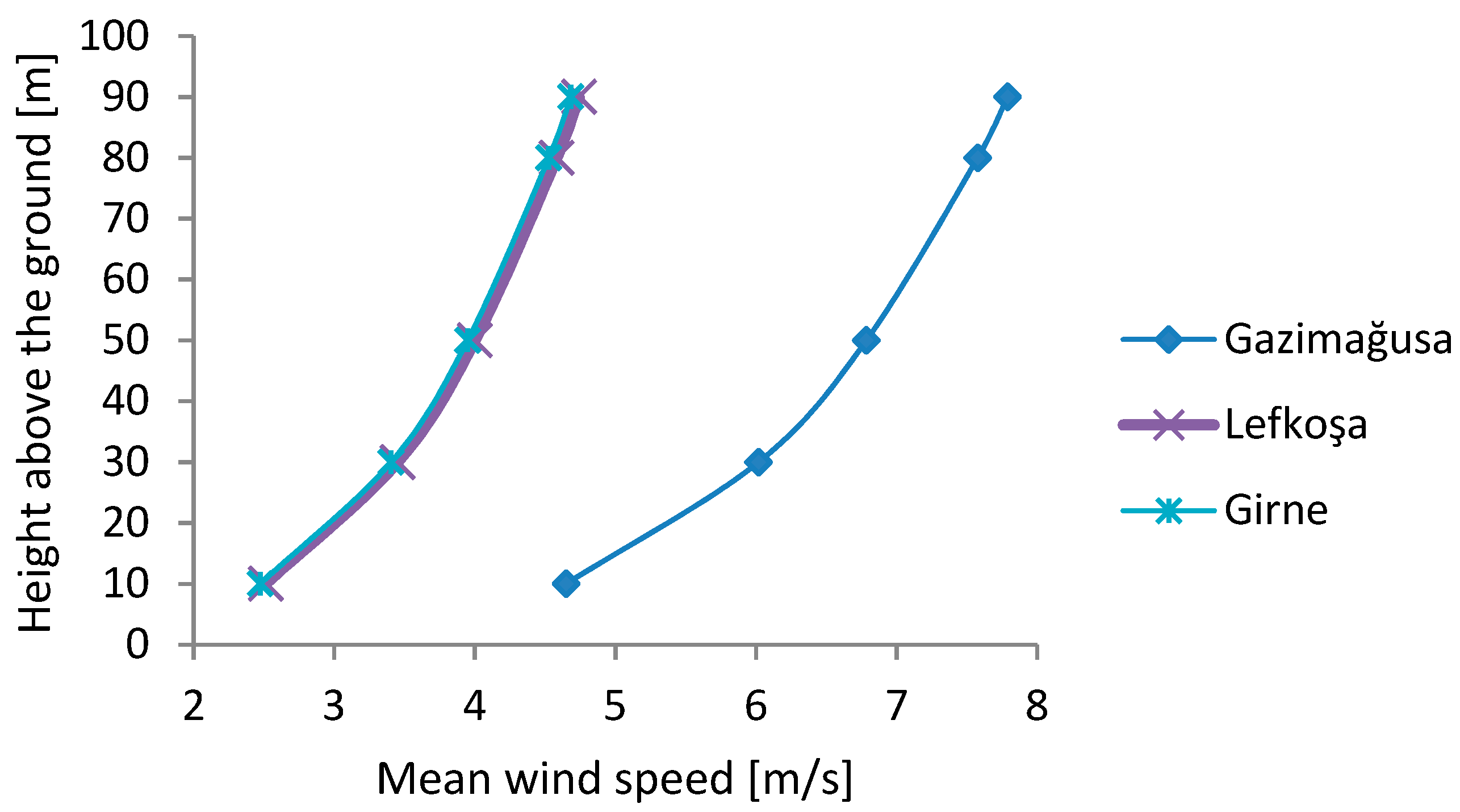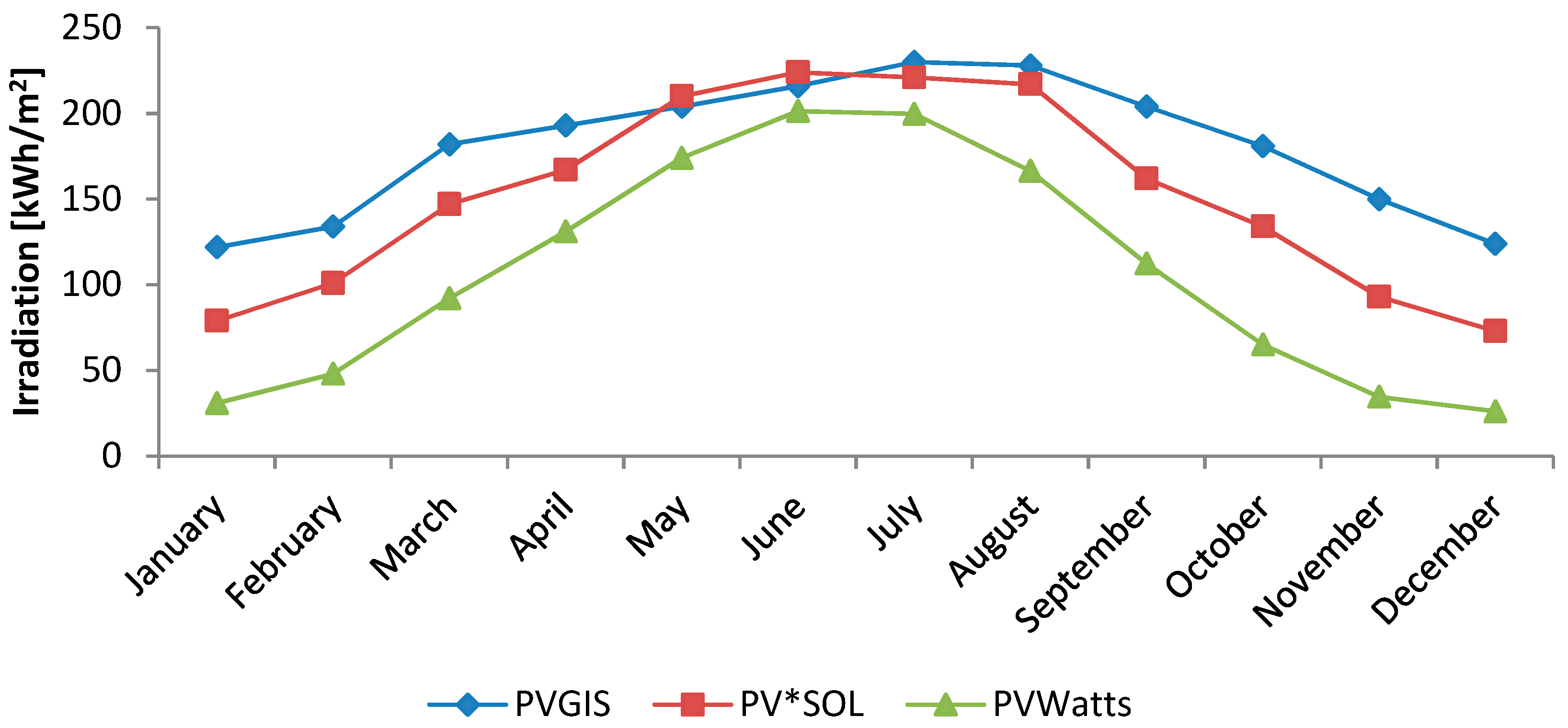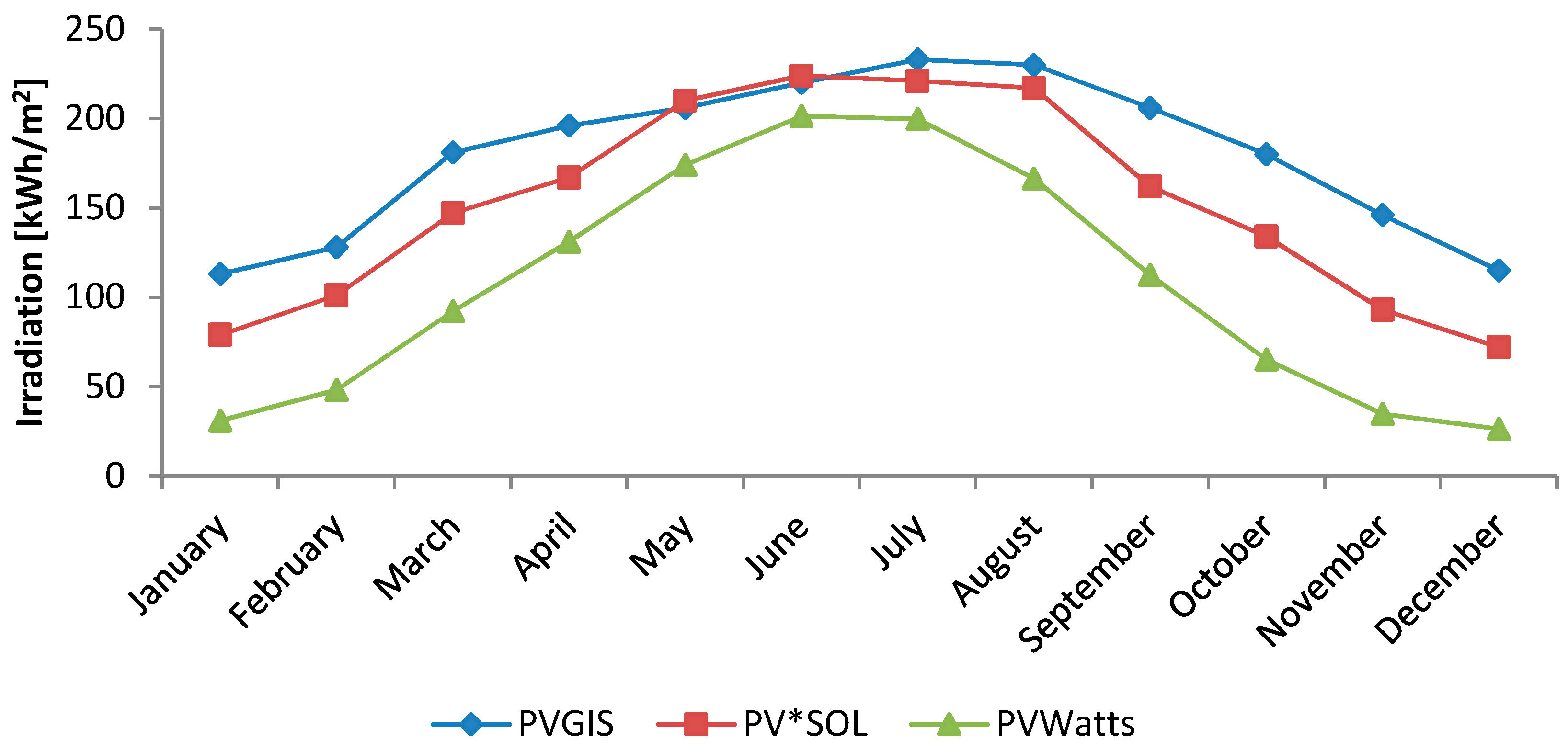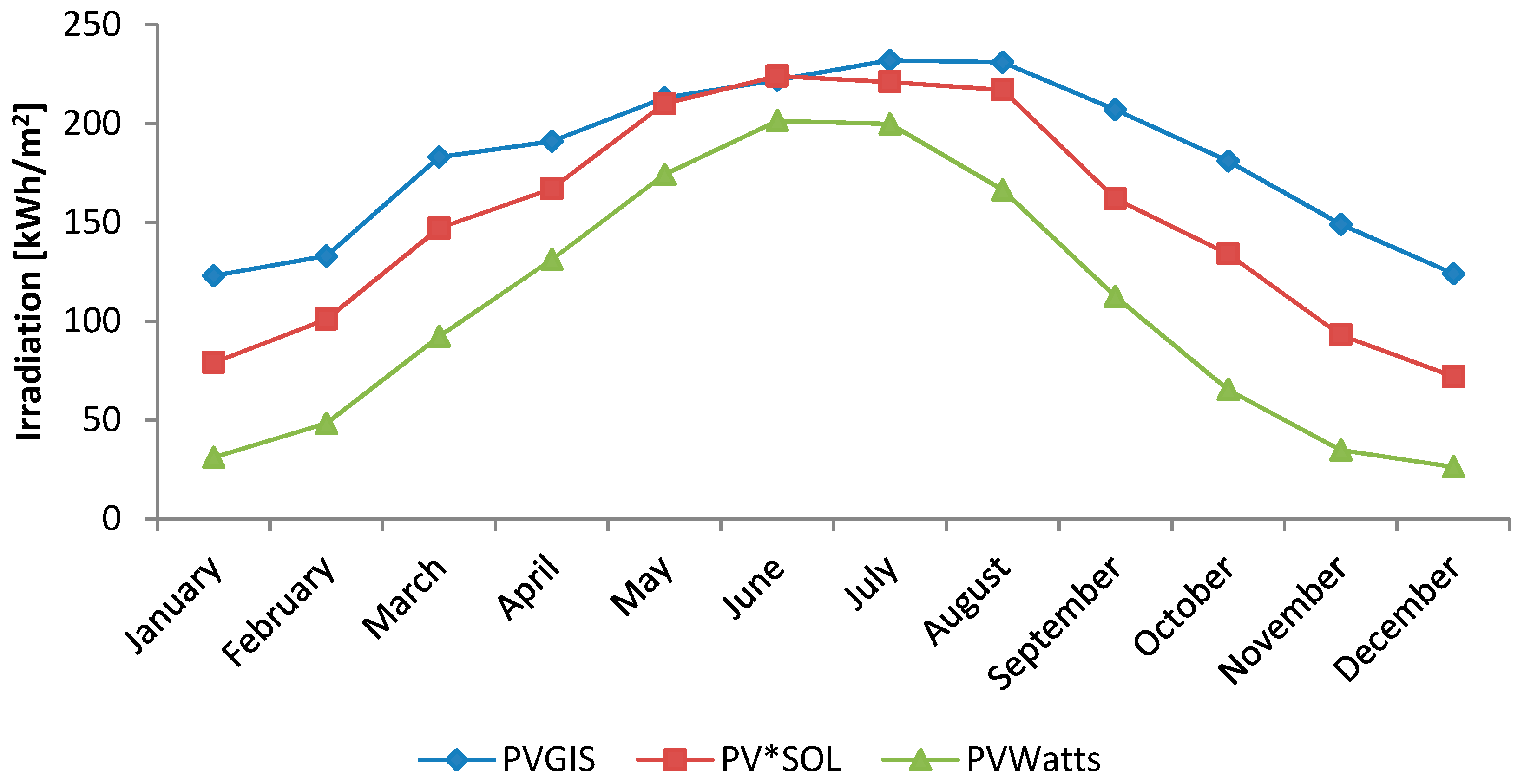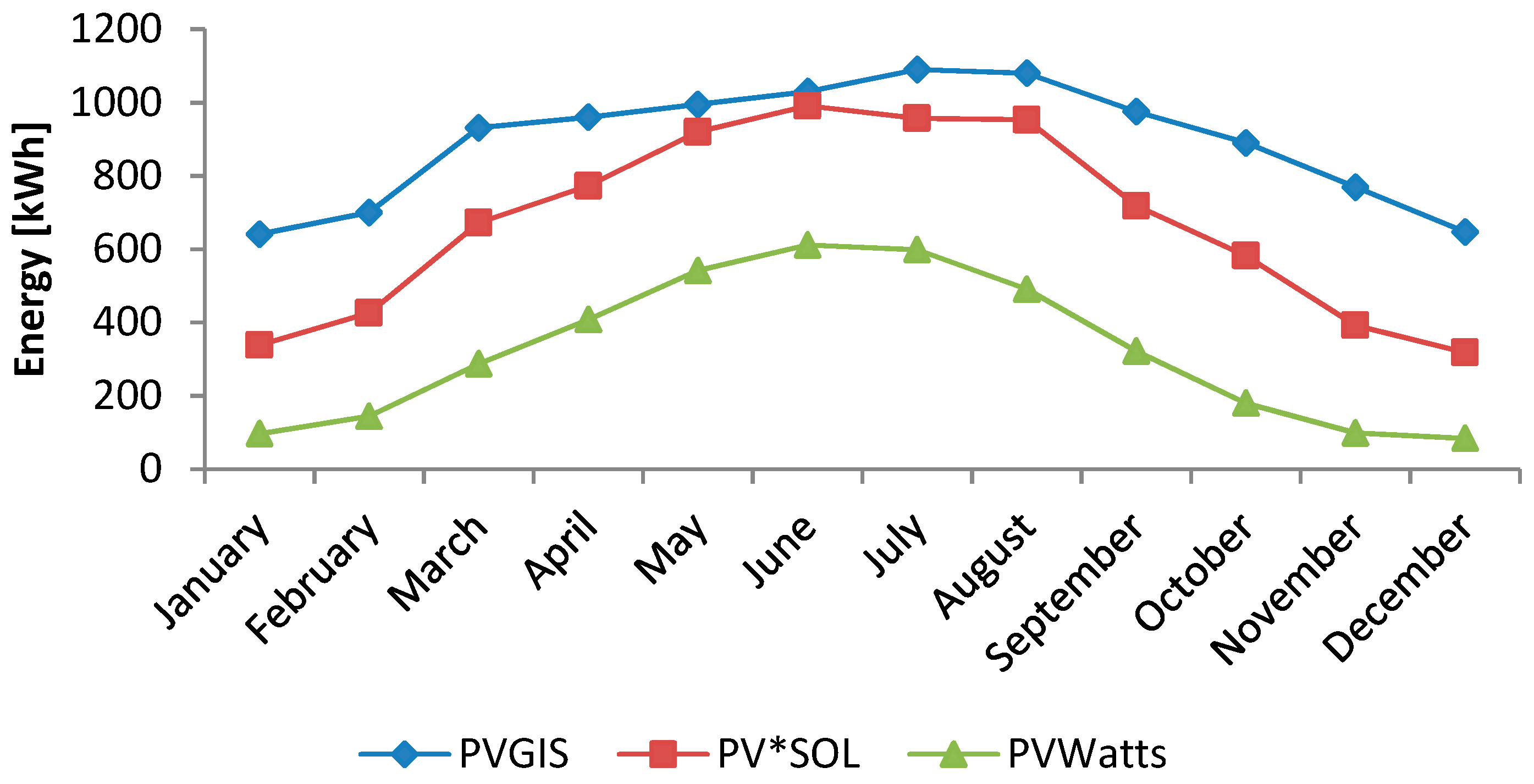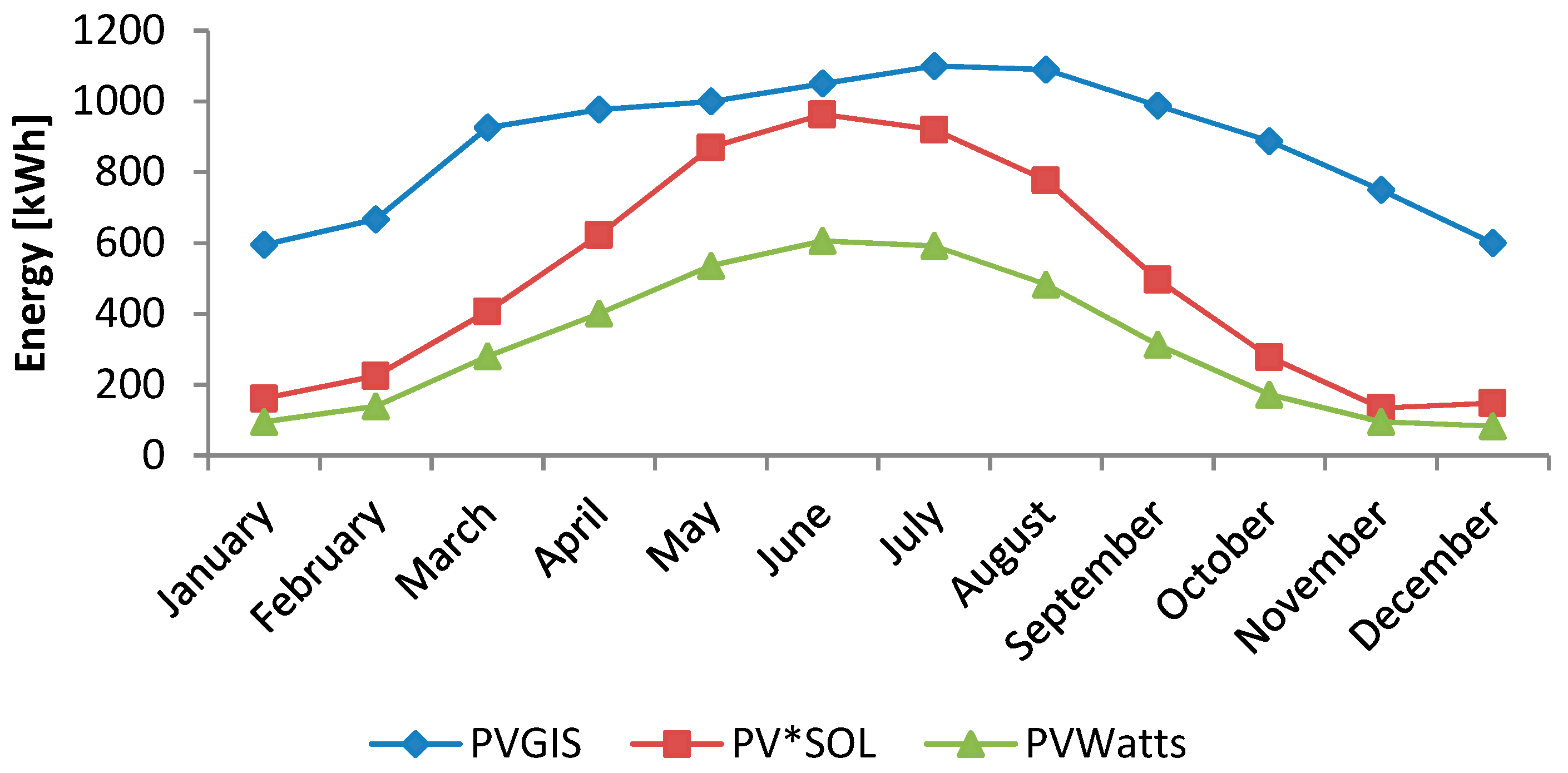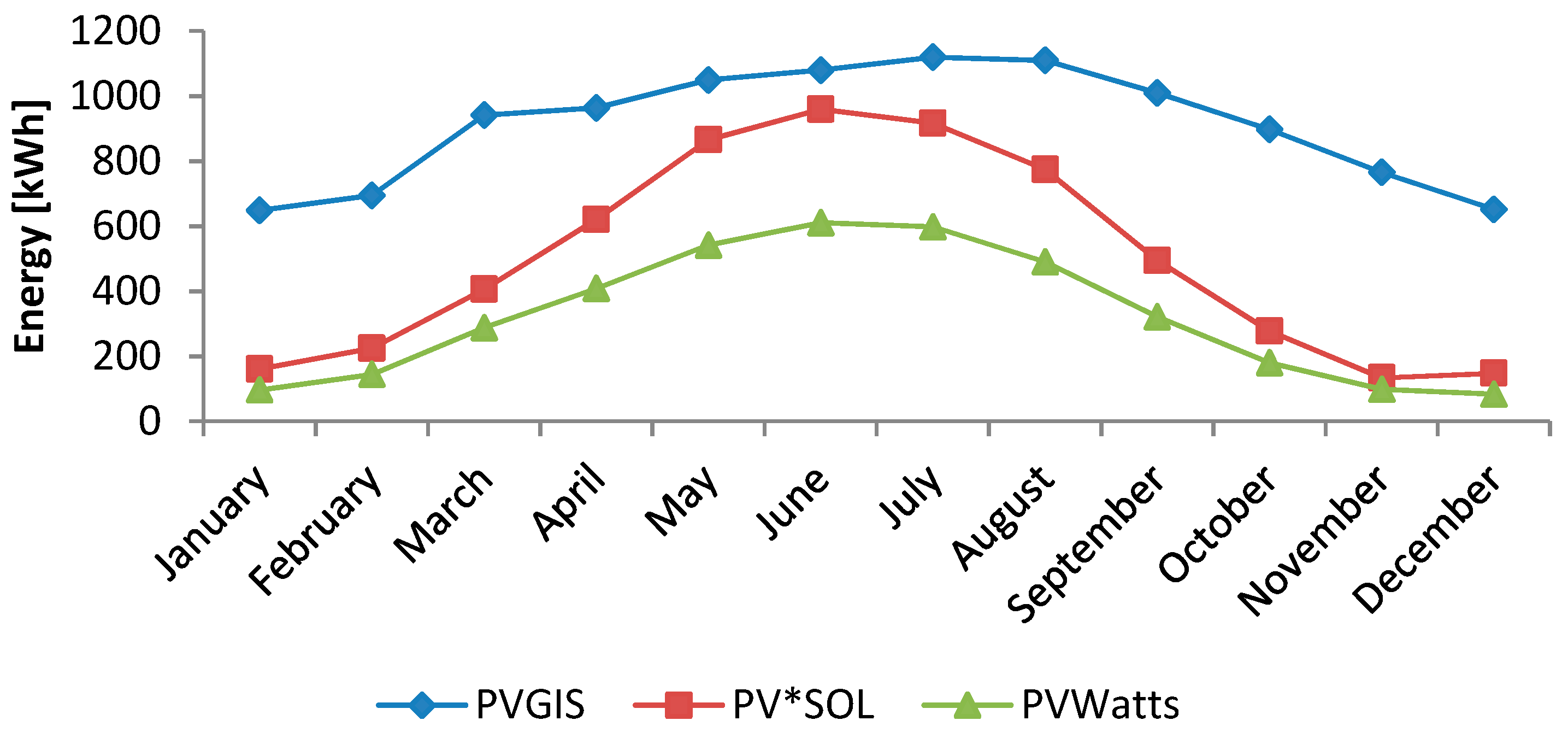1. Introduction
In Northern Cyprus, the electricity is currently produced using diesel generator power stations and PV power plant, which have been installed in Serhatköy with capacities of 212 MW and 1.27 MW, respectively [
1,
2]. Moreover, the growth of the population has led to an increase in energy demand, where nearly all of the energy production is currently dependent on fossil fuels. The increasing demand placed on conventional sources has encouraged the authors to investigate the field of renewable energy sources for generating electricity in the Northern part of Cyprus, especially wind and solar energy.
Renewable energy sources are considered by many as clean alternatives to fossil fuels that can provide sustainable energy solutions [
3,
4,
5]. Renewable energies such as wind and solar energy are recognized as alternative resources for generating electricity in the future [
6]. A key advantage of solar and wind energy is that they avoid carbon dioxide emissions [
7]. Wind energy and sunlight can be converted directly into electricity using wind turbines and solar photovoltaic (PV) systems, respectively [
8]. They are now used extensively for meeting the electricity demand in many countries such as India [
9], Pakistan [
10], Turkey [
11] and Saudi Arabia [
12].
Several researchers have studied the wind and solar potential of various locations around the world [
2,
13,
14,
15,
16,
17,
18,
19]. For instance, Alayat et al. [
13] made techno-economic assessment of the wind power potential for eight locations, namely, Lefkoşa, Ercan, Girne, Güzelyurt, Gazimağusa, Dipkarpaz, YeniBoğaziçi, and Salamis, distributed over the Northern part of Cyprus. The results showed that small-scale wind turbine use could be suitable for generating electricity in the studied locations. Kassem et al. [
2] evaluated the economic feasibility of 12 MW grid-connected wind farms and PV plants for producing electricity in Girne and Lefkoşa in Northern Cyprus. The authors concluded that PV plants are the most economical option compared to wind farms for generating electricity in the studied regions. Kassem et al. [
14] analyzed the wind power potential in the Salamis region of Northern Cyprus. They found that high capacity wind turbines (MW) are not suitable for electricity production in the region based on the wind power density value. Solyali et al. [
15] studied the wind power potential for the Selvili-Tepe location in Northern Cyprus. The authors found that the wind energy resources at this location are classified as marginal (wind power class is 2). Kassem and Gökçekuş [
16] conducted a techno-economic assessment of a proposed 1MW grid-connected PV power plant in the town of Lefke. The analysis results showed that a PV plant could be used as a viable alternative for reducing the GHG emissions in Northern Cyprus and generating electricity from environmentally friendly sources. Azad et al. [
17] investigated the wind energy assessment at different hub heights in desired locations using the Weibull distribution function. The results showed that the wind power sources in the site are categorized as poor. Albani and Ibrahim [
18] analyzed the wind energy potential at three coastal locations in Malaysia. They concluded that the production of wind energy is only feasible and practical at certain locations in Malaysia. Mohammadi et al. [
19] presented a techno-economic analysis of developing 5MW grid-connected PV power plants in Iran. The results indicated that the 1-axis tracking system is the most economical option compared to fixed tilt and 2-axis tracking systems. Huang et al. [
20] estimated the solar radiation on building roofs in an urban area in China using three models. They found that the SHORTWAVE-C model can accurately estimate the solar radiation intensity in a complex urban environment under cloudy conditions, and the GPU acceleration method can reduce the computation time by up to 46%.
As a continuation of authors’ studies on renewable energy potential in Northern Cyprus, this paper aims to provide a better understanding of the relationship between renewable technologies (wind turbines and PV) and the cheapest energy cost at urban regions located in the Northern part of Cyprus. In this regard, the goals of the current study are divided into two parts. In the first part, the wind energy potential of the Northern part of the island based on three selected locations (Lefkoşa, Girne, and Gazimağusa) is analyzed using the Weibull distribution function. In addition, the maximum likelihood method is used to determine the Weibull parameters. Furthermore, an economic study of 12 wind turbine models in the selected regions using the method of the present value of costs is evaluated. In the second part, the paper aims to assess and characterize the solar potential in three urban regions (Lefkoşa, Girne, and Gazimağusa). Three kinds of simulation software, namely PVGIS, PV*SOL, and PVWatts, are used to evaluate the performance of a 6.4 kWp grid-connected rooftop PV system for the household. Moreover, this study compares the annual energy yield, performance ratio and energy yield of the PV system from various software. The overall objective of the study is to determine the best and cheapest renewable technologies in terms of PV systems and wind turbines that can be used to generate electricity at three different locations in Northern Cyprus.
The rest of the paper is structured as follows:
Section 2 presents overall information about the collected wind data, wind data adjustment, and analysis procedure.
Section 3 describes the wind speed characteristics at the studied locations and analyzes the wind power densities at different heights to evaluate the wind energy potential in detail. It also discusses the economic evaluation and the performance of small-scale vertical and horizontal axis wind turbines. Furthermore, the solar resource potential, energy generation and performance comparison between the three different simulations tools are presented in
Section 3.
Section 4 presents the discussions, and
Section 5 provides significant conclusions.
4. Discussion
With rapid growth in populations, energy consumption is expected to increase in the future. Moreover, the increased energy demand and environmental problems caused by burning fossil fuels have raised interest in alternative energy sources, particularly in urban environments. The aim of this study is to investigate the wind and solar potential at three urban regions in the Northern part of Cyprus.
The results of the collected wind speed data and the analysis show that the annual actual wind speeds at the selected regions are 2.47 for Girne, 2.50 m/s for Lefkoşa and 4.65 m/s for Gazimağusa (
Figure 3). Thus, according to the results obtained at a height of 10 m, Gazimağusa has higher wind speeds compared to the other regions (Lefkoşa and Girne), which is confirmed by [
43]. Based on the wind power density classes, the evaluation of the wind resource available in the three selected locations as class 1 wind power sites indicates their suitability for small-scale wind turbines (
Table 6). From the perspective of the costs of generating electricity, the AWT(2)2000 model has lower values of electricity cost compared to the other models. Additionally, the wind system for Gazimağusa is a more economical option for generating electricity because it has higher capacity factor values as well as lower energy cost per kWh values.
Furthermore, the solar rooftop PV system is an attractive alternate electricity source for households. In addition, the potential of a solar PV at a given site can be evaluated through software simulation tools [
44]. The performance ratio of PVGIS is the highest compared to PV*SOL and PVWatts; our results are thus in good agreement with those found by [
44]. Based on the analysis, the maximum and minimum annual energy yields are estimated to be 1708.75 kWh/kWp for Gazimağusa and 1661.09 kWh/kWp for Girne. It is shown that the grid-connected system installations are technically viable energy solutions for the selected area.
Out of three simulation software tools, PVGIS is found to be the most widely used and most effective tool because of its ability to carry out multiple analyses, which makes it easier and faster to evaluate different system configurations. In fact, according to Ref. [
45], the performance ratio of the Serhatköy PV Power Plant, which is located in the Northern part of Cyprus, is about 73.7%. Based on the results in
Table 9, only PVGIS has a performance ration value close to that of Serhatköy. Therefore, PVGIS can be considered as a reliable software tool for the simulation of a solar PV system.
Moreover, the authors performed an economic evaluation of developing gird-connected solar/wind power systems for the urban regions. It is found that the relevant authorities are not willing to invest in this type of technology due to high electricity prices and the poor recovery of initial investment. This type of technology is also not suitable for use in Lefkoşa and Girne due to the low capacity factor. In addition, it is observed that PV systems are the most economical option for generating electricity in comparison to producing electricity by wind turbines because of the lower value of the cost of energy per kWh.
According to Kibris Türk Elektrik Kurumu (2018) [
46], the diesel electricity cost is about 0.15
$/kWh (0–250 kWh) and 0.17
$/kWh (250–500 kWh). The current results show that these systems are the most economical option for generating electricity in comparison to producing electricity by diesel generators because of the lower value of the cost of energy per kWh. The results show that using a solar system for producing electricity in Northern Cyprus could reduce the electricity costs by an average of 70% compared to diesel electricity costs. Moreover, the net fuel savings provided by electricity-generation system with solar systems are nearly three times greater than those obtained with wind systems.
5. Conclusions and Future Works
Urban wind and solar energy consist of the utilization of wind and solar energy technology in applications in urban and suburban built environments. In this assessment, 2010–2016 wind speed data for three urban regions in Northern Cyprus have been used to investigate the potential for generating electricity from wind energy. The Weibull distribution function was used to analyze the wind speed characteristics in the selected regions. The Power law method was used to estimate the wind speeds at various hub heights. A techno-economic assessment was made for the generation of electricity using 12 wind turbines with various characteristics and types in all the studied regions. Moreover, this paper analyzed the solar energy potential based on three simulation tools. The performance of a grid-connected rooftop solar photovoltaic system in terms of energy generation, performance ratio and capacity factor has been analyzed. The main outcomes of the study are:
All the considered regions have annual mean wind speeds above 2 m/s, and the wind power densities range between 11.72 W/m2 and 68.49 W/m2 at a height of 10 m. The wind power analysis shows that Gazimağusa is the best location for harvesting wind energy.
AWT(2)2000 model with a power rating of 4 kW has the lowest energy production cost among the considered wind turbine technologies.
Vertical axis wind turbines have significant potential to generate electricity for the urban environment.
Among the simulation software studied, PVGIS has been demonstrated to be an easy, fast, and reliable software tool for the simulation of solar PV systems in the studied towns.
In comparison with solar and wind systems, PV systems are the best option for producing electricity in the studied regions.
It is concluded that the PV system project is the most economical option for generating electricity in the studied locations compared with the wind system due to the low electricity prices and recovery of initial investment.
Based on the overall performance of the rooftop solar PV power plant, it is evident that solar PV power is a feasible solution for supplying power and reducing the large volume of CO2 emissions emitted into the atmosphere.
Generally, solar radiation can be considered constant in a wide area, but wind is a local resource, and it must be studied in the exact location. The prediction of wind speed in the built environment is difficult due to the varying roughness and the drag exerted by surface-mounted obstacles on the flow, which reduce the wind speed close to the ground. Therefore, it is conceivable that there is a lack of accurate approaches for the assessment of wind speed in urban areas. An interesting area for future study is Computational Fluid Dynamics (CFD), which can be used to predict the wind speed in urban environments (selected regions) for conventional buildings. In addition, the evaluation of potential locations for the installation of small-scale wind turbines in urban areas can be investigated using CFD.
